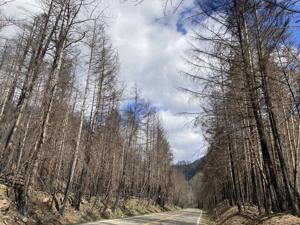Report: Oregon’s wildfire cleanup on track despite criticism

(The Center Square) – Oregon is working to remove thousands of damaged trees littering its roads and properties months after being blackened by last year’s wildfires. A new report finds those efforts are on the right track despite criticisms from local residents and whistleblowers.
Last year’s wildfires burned a million acres and took some 4,000 homes with them. It left behind scores of burnt trees littering the highways and cul-de-sacs. The Oregon Department of Transportation (ODOT) was tasked with clean-up duty, removing 295,000 dead trees, based on preliminary estimates. It paid CDR Maguire, a Florida firm, $75.5 million to supervise its efforts.
The operation has drawn allegations of mismanagement and excessive cutting from residents and whistleblowers who claim ODOT workers culled healthy trees along with dead ones. After hearing these claims, state lawmakers requested Gov. Kate Brown stop the operation. She did not.
Speaking with the House Special Committee on Wildfire Recovery on April 30, ex-CDR field monitor Eric Philips described the operation to state lawmakers as disorganized and chaotic.
“Some of these guys were brand new and had never put a chainsaw into a Doug fir before,” Phillips said. “You have 40 people out there tagging trees and maybe a couple of arborists. It became, for a lack of a better word, a point-and-click.”
Which trees were targeted for removal, Philips said, were often picked at random by inexperienced workers. Phillips supervised operations at the Holiday Farm and Beachie Creek sites, where he alleged healthy trees were tagged for removal.
“I remember asking one of them why they marked them for removal, “What’s wrong with these trees?'” Phillips said. “She said, ‘Well, they don’t have any leaves.’ It’s January. She’s from Florida. I guess trees don’t lose their leaves in Florida.”
Phillips told the committee CDR was “losing control” by that point. He said he felt there was no recourse or accountability from higher-ups at ODOT.
“Every time I tried to speak up, I was pretty much told I was just a monitor,” Phillips said. “Be quiet. Don’t tell us how to do our job.”
Over the following weeks, the state hired arborist Galen Wright, president of the Washington Forestry Consultants, to review ODOT’s tree-removal process. In his 23-page report, Wright found that 98% of the 1,200 ODOT employees working in the field were qualified for their jobs. One out of the operation’s 40 arborists fell short of meeting their job qualifications, the report states.
Wright concluded that 99% of the trees marked for removal by ODOT were dead or in poor health based on 2,214 samples taken from ODOT operation sites over three weeks. He found 96% of the trees were tagged correctly.
“ODOT has the necessary operational plan, protocols, contracts, and requirements necessary to conduct the assessment operations and provide quality assurance to this hazard tree mitigation program for the 2020 Oregon wildfires,” Wright wrote in his report.
State Rep. Brian Clem, D-Salem, who chairs the House Wildfire committee, said in April that political pressure from state legislature did not help the situation.
“We’ll take responsibility that we started bringing ODOT in every single week and telling them to work at a faster pace because we want recovery,” Clem said. “We’ve been told by California that people won’t go back as long as things are hazardous.”
Oregon’s forest practices have long been a target for environmentalist groups.
A coalition of conservation groups filed a lawsuit against the state Department of Forestry in April challenging post-fire clearcutting in the Santiam State Forest. It alleges post-fire salvage logging harms watersheds, delays forest recovery and contributes to carbon pollution.
Scientific literature on the matter is mixed. A 2019 USDA report suggests post-fire clearcutting has some adverse effects on select wildlife and vegetation but warrants further study.
The lawsuit, filed in Multnomah County Circuit Court, awaits judicial action.
Disclaimer: This content is distributed by The Center Square

